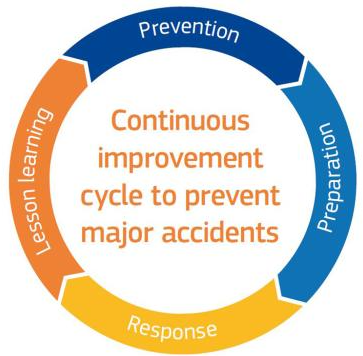Syllabus: GS3/Planning; Employment; Infrastructure
Context
- The recurrence of industrial disasters highlights the urgent need for meaningful reforms in the inspection process. In recent years, fatal accidents in factories have resulted in loss of lives, injuries, and damage to property.
About the Factory Accidents in India
- Industrial accidents pose significant risks to workers, communities, and the environment. In India, these incidents have been a cause for concern, affecting lives, livelihoods, and economic productivity.
- WHO/ILO Joint Estimates of Work-related Burden of Disease and Injury: According to the World Health Organization (WHO) and International Labour Organization (ILO), work-related diseases and injuries due to respiratory and cardiovascular diseases, that includes deaths related to Non-communicable diseases majorly, with chronic obstructive pulmonary disease, stroke, and ischaemic heart disease being the leading causes.
- According to data by the National Disaster Management Authority (NDMA), 130 significant chemical accidents have been reported, which resulted in 259 deaths and left 563 people with major injuries in the past ten years.
- Major industrial disasters include Bhopal Gas Tragedy (1984), Visakhapatnam Gas Leak (2020), Chennai Oil Spill (2017), and Neyveli Boiler Blast (2020) etc.
- Recent Incidents: In May 2024, an explosion occurred in a chemical factory in the Dombivli Maharashtra Industrial Development Corporation (MIDC) area, resulting in loss of lives, injuries, and damage to nearby properties.
- Unfortunately, this is not an isolated incident. Fatal industrial accidents have been frequent in recent years.
Reasons Highlighted For Accidents
- Inadequate Safety Measures: Some industries do not adhere to safety standards due to loopholes in regulations or insufficient monitoring by regulatory authorities.
- Fatal industrial accidents have been alarmingly frequent, with incidents reported in 2016, 2018, 2020, and 2023.
- Shockingly, the boiler in the chemical factory involved in the recent explosion was not even registered under the Indian Boiler Regulations, 1950.
- Human error like negligence and fatigue often lead to accidents.
- Low Inspection Rates: The inspection rates for hazardous factories are alarmingly low. For instance:
- In Maharashtra, only 23.89% of hazardous factories were inspected in 2021.
- Tamil Nadu had a general inspection rate of 17.04% and a hazardous factories inspection rate of 25.39%.
- Gujarat’s inspection rates were 19.33% (general) and 19.81% (hazardous).
- Nationally, the figures were 14.65% (general) and 26.02% (hazardous).
- Poor Prosecution Rates: The prosecution rates (decided cases as a percentage of total prosecutions) are also disheartening and far from satisfactory.
- Gujarat: 6.95%
- Maharashtra: 13.84%
- Tamil Nadu: 14.45%
- Shortage of Personnel: One reason for poor inspection rates is the shortage of personnel. In Maharashtra, only 39.34% of sanctioned officers were appointed. Gujarat and Tamil Nadu fared slightly better, but the overall situation remains inadequate.
- Other key reasons are lack of training and awareness, equipment failure, chemical and process safety, lack of emergency preparedness, and informal workforce etc.
Prevention
- Strengthening Labor Inspection: To enhance safety and prevent accidents, India must address the following:
- Personnel Allocation: Increase the number of inspectors and ensure adequate coverage.
- Efficient Inspections: Reduce the workload per inspector to maintain the deterrent effect. Increase the number of inspectors and allocate adequate resources to ensure comprehensive inspections of all factories.
- Prosecution: Improve prosecution rates to hold violators accountable.
- Streamline Regulatory Processes: Simplify and expedite the registration and compliance procedures for factories.
- Accountability and Enforcement: Hold violators accountable through stricter enforcement and timely prosecutions.
- Worker Safety First: Prioritise worker safety over profit margins and business interests.
Related Government’s Initiatives
- National Policy on Safety, Health and Environment at Workplace (NPSHEW): It aims to promote a preventive safety culture in industries and workplaces, and to integrate safety, health, and environmental concerns into the decision-making processes of industries and improve the overall safety performance.
- Industrial Safety and Disaster Management Plans: The government mandates industries to develop and implement safety and disaster management plans to mitigate the risks of industrial accidents.
- These plans include measures for risk assessment, emergency response, evacuation procedures, and training programs for employees.
- National Disaster Management Authority (NDMA): The NDMA plays a crucial role in disaster preparedness, response, and mitigation across various sectors, including industrial safety.
- It formulates policies, plans, and guidelines for disaster management and works with relevant stakeholders to ensure effective coordination during emergencies.
- Bureau of Indian Standards (BIS): BIS develops and maintains standards for industrial safety equipment, materials, and processes to ensure compliance with safety regulations.
- Labour Inspection and Enforcement: The government conducts regular inspections of industrial establishments to assess compliance with safety regulations and identify potential risks.
- Strict enforcement measures are taken against violators to ensure accountability and deterrence.
Related Global Efforts
- Global Strategy on Occupational Safety and Health (2024-2030): The International Labour Organization (ILO) has introduced a new plan to prioritise workers’ well-being.
- It aims to enhance safety and health in workplaces worldwide, aligning with the ILO’s commitment to social justice and decent work.
International Tools and Support
- Organisation for Economic Co-operation and Development (OECD): Provides policy guidance for the prevention, preparedness, and response to chemical accidents.
- EU Policy: Focuses on major-accident hazards.
- UN Environment: Supports prevention and preparedness at local and national levels.
- WHO: Manages public health during chemical incidents.
- United Nations Office for Disaster Risk Reduction (UNISDR): Advocates for a new framework for disaster risk reduction.
- Organisation for the Prohibition of Chemical Weapons (OPCW): Implements chemical safety and security programs.
Conclusion
- Labour market governance through the inspection system needs urgent reform. Only then can we prevent factory accidents and protect workers’ lives.
- Given the fast-paced changes in technology and the use of hazardous and chemical substances, increased inspection is crucial.
| Daily Mains Practice Question [Q] Discuss the challenges faced by Indian factories in ensuring workplace safety and preventing accidents. What are some specific reforms or policies that could improve safety standards? |
Previous article
Bail Reform in India: A Path to Justice
Next article
Multidimensional Poverty Index (MPI) 2023